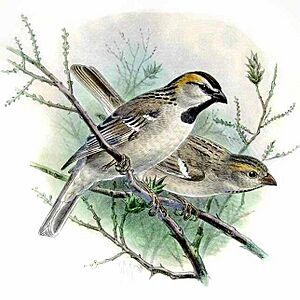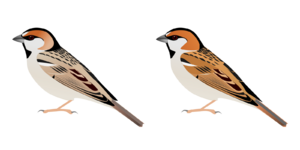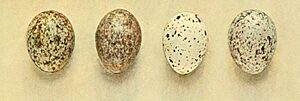Saxaul sparrow facts for kids
Quick facts for kids Saxaul sparrow |
|
|---|---|
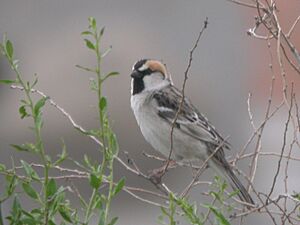 |
|
| A breeding male of the subspecies ammodendri in southeastern Kazakhstan | |
| Conservation status | |
| Scientific classification | |
| Genus: |
Passer
|
| Species: |
ammodendri
|
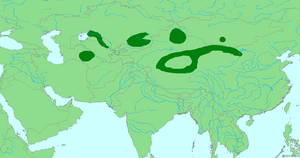 |
|
| Approximate range of the saxaul sparrow | |
| Synonyms | |
|
Passer ammodendri Severtzov, 1873 |
|
The saxaul sparrow (Passer ammodendri) is a type of passerine bird. It belongs to the sparrow family, Passeridae. You can find this bird in parts of Central Asia.
It is one of the larger sparrows, about 14 to 16 centimeters (5.5 to 6.3 inches) long. It weighs between 25 and 32 grams (0.9 to 1.1 ounces). Both male and female saxaul sparrows have feathers that are dull grey to sandy brown. Their legs are pale brown.
Female sparrows have less bright colors and bills. They do not have the strong black stripes on their heads like the males. The unique head markings of both sexes make the saxaul sparrow easy to spot. You probably won't confuse it with other birds.
Its calls are soft and musical chirps. It also has a special song and a call it makes while flying.
Scientists recognize three different types, or subspecies, of the saxaul sparrow. These types differ in their feather colors and the female's head stripes. The ammodendri subspecies lives in the western part of its range. The stoliczkae and nigricans subspecies live in the east.
The saxaul sparrow lives in six separate areas across Central Asia. These areas stretch from central Turkmenistan to northern Gansu in China. This bird loves deserts, especially places with shrubs like the saxaul plant. It often lives near rivers and oases.
Even though it has lost some of its living areas due to farming, human activities do not seriously threaten it.
Not much is known about the saxaul sparrow's daily life. It often hides in plants and looks for food in trees and on the ground. It mainly eats seeds. When it is raising young, it also eats insects.
When not breeding, these sparrows form groups that move around. However, they are less social than other sparrows when breeding. They often build their nests alone or in pairs. Their nests are round bundles of dry plants. They line them with soft things like feathers.
They build nests in holes in trees, earth banks, rocky slopes, and even in human-made structures. Sometimes they use the old nests of birds of prey. They usually lay two sets of five or six eggs each season. Both parents help build the nest and take care of the eggs and young birds.
Contents
What Does the Saxaul Sparrow Look Like?
The saxaul sparrow is one of the bigger sparrows. It measures about 14 to 16 centimeters (5.5 to 6.3 inches) long. It weighs between 25 and 32 grams (0.9 to 1.1 ounces). Its wings are 7.1 to 8.1 centimeters (2.8 to 3.2 inches) long. Males are usually a bit larger than females.
Its tail is short, about 6.3 to 6.95 centimeters (2.5 to 2.7 inches) long. The sparrow's legs are pale or pinkish brown. Its lower leg bone, called the tarsus, is about 1.95 centimeters (0.77 inches) long.
The bill, or beak, is 1.0 to 1.3 centimeters (0.39 to 0.51 inches) long. Young birds have a pale grey bill. Breeding females have a pale yellowish bill with a black tip. Breeding males have a black bill. Like all sparrows, it flies quickly and often high in the sky.
Special Markings
The saxaul sparrow has special markings, especially on its head. These markings make it easy to tell apart from other birds. Its feathers are dull, ranging from dull grey to warm sandy brown. The color can vary between different subspecies and even within the same subspecies.
Birds of the ammodendri subspecies are sandy grey. The nigricans birds are similar but darker. The stoliczkae birds are warm brown or russet. Some stoliczkae birds and those from the southwest of the ammodendri range do not have streaks on their lower back and upper tail feathers. Sparrows in Mongolia have a bigger, deeper bill and wide bluish streaks on their chest.
Male and Female Differences
The male saxaul sparrow has bold markings. It has a black stripe along the top of its head and another through its eye. It also has black feathers, like a "bib," on its throat and upper chest. This bib is thin on the throat but wide on the chest compared to other sparrows.
The male has a bright russet (reddish-brown) patch on the sides of its head and the back of its neck. Its cheeks are pale grey or buff. Its belly is whitish, with a slight buff or grey tint on its sides. Its back is grey or warm brown, with varying black streaks. Its shoulders have lighter black bars. The male's thin tail is brown, with lighter edges and tips on the feathers.
The female looks similar to the male but is paler and duller. It is sandy grey or brown. Its back has a pattern like the male's, and its belly is white or whitish. The females of the ammodendri and nigricans subspecies have a dull grey head. They have darker smudges on their forehead, behind their eyes, and on their throat.
The female of the stoliczkae subspecies is buff-brown. It has a white throat and a clear pale stripe above its eye. Its forehead is darker, and its cheeks are lighter. Young sparrows look like females. They do not have dark tinges on their throat and head. Adult sparrows change their feathers, or moult, from July to early September. Young birds moult completely from June to August.
Sounds and Calls
Not much is written about the saxaul sparrow's calls. Its common call is a chirp, like "cheerp cheerp." This call is softer and more musical than the call of the house sparrow. It makes a flight call that sounds like "twerp." A Russian naturalist, V. N. Shnitnikov, described its song as "not loud, but pleasantly melodious with fairly diversified intonations."
How Scientists Study the Saxaul Sparrow
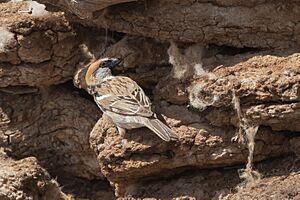
The saxaul sparrow was first described by an English zoologist named John Gould. This happened in March 1872. He wrote about it in his book The Birds of Asia. The first bird specimen was found near Kyzylorda, in southern Kazakhstan. It was collected by a Russian naturalist, Nikolai Severtzov.
Severtzov had planned to describe this bird as Passer ammodendri for several years. He had even shared specimens with other naturalists. Gould got some specimens from a rare bird collection shown in London. Severtzov did not describe the species until 1873. However, Gould's description came first, so he gets the credit.
The bird's species name, ammodendri, comes from its desert home. It refers to the Ammodendron or sand acacia tree. This tree's name comes from ancient Greek words meaning "sand" and "tree." The English name "saxaul sparrow" refers to the saxaul plant. The bird is often found near this plant.
The saxaul sparrow is usually placed in the genus Passer. This genus also includes the house sparrow and about twenty other species. However, a separate genus called Ammopasser was created for it in 1890.
Different Types of Saxaul Sparrows
The saxaul sparrow lives in six areas across Central Asia. These areas are probably separate from each other. Scientists divide the bird into at least three subspecies.
The main subspecies, Passer ammodendri ammodendri, lives in three of these areas. One area is in the Syr Darya basin of Kazakhstan and Uzbekistan. Another is south of Lake Balkhash and north of Almaty. Here, it is common only in the Ili River valley.
In a third area, sometimes called korejewi, ammodendri birds breed in parts of central Turkmenistan, Iran, and possibly Afghanistan. They fly south during the winter.
The subspecies stoliczkae was named in 1874 after Ferdinand Stoliczka. This type is found across a large part of China. It stretches from Kashgar east to the far west of Inner Mongolia. It lives around the Taklamakan Desert and through eastern Xinjiang, northern Gansu, and southern Mongolia.
In the far west of the Gobi Desert, there is another group of stoliczkae birds. They are separated by mountains and sometimes called timidus. The subspecies nigricans was described in 1961. It is found in northern Xinjiang's Manasi River valley.
Where the Saxaul Sparrow Lives
The saxaul sparrow lives in remote parts of Central Asia. Its home is thought to be in six separate areas. However, this is not fully certain because there are not many records.
It lives in deserts, especially near rivers and oases. You usually find it around shrubs like saxaul (Haloxylon), poplar (Populus), or tamarisk (Tamarix). Sometimes, it lives near towns and grain fields, especially in winter.
Scientists do not believe it is in danger. It is common in many places across its wide range. Because of this, it is listed as Least Concern on the IUCN Red List. However, it has lost large parts of its home. This is due to more farming and desertification caused by too much grazing by animals.
Saxaul Sparrow Behaviour and Life Cycle
Not much is known about the saxaul sparrow's behavior. This is because it lives in remote areas. In many places, it is shy and spends a lot of time hidden in plants. But breeding birds in Mongolia were reported to be "quite friendly."
When not breeding, it is social. It can form groups of up to fifty birds. Sometimes, it joins Eurasian tree, Spanish, and house sparrows. In some areas, it makes small local migrations. As spring arrives, saxaul sparrows form pairs within their group. Then they spread out in April.
What They Eat
Seeds, especially those from the saxaul plant, make up most of its diet. It also eats insects, especially when it is breeding. Common insects it eats are weevils, grasshoppers, and caterpillars. It looks for food in trees and on the ground.
A study in the Ili River valley looked at insects fed to young sparrows. It found that beetles were the main food. Weevils made up 60 percent of the young birds' diet. Coccinellidae (ladybugs) made up 30 percent. Because it lives in the desert and is not very common, it does not cause problems for farms. If water is not nearby, the saxaul sparrow may fly long distances several times a day to drink.
Nesting and Reproduction
The saxaul sparrow is less social than other sparrows when breeding. This is because of its dry home and its choice of nesting spots. It likes to nest in holes in trees and earth banks. Usually, pairs nest alone. But sometimes, they breed in small groups. They may even nest with house and Eurasian tree sparrows.
The breeding season is short, from May to July. Most young birds are raised in April and June. It is unusual for a sparrow, but it has not been seen nesting openly in tree branches. This might be because there are not many published records. Nests are often built in tree holes, sometimes close together.
Other common nesting places are earth banks and rocky slopes. Nests have also been found in the nests of birds of prey, empty buildings, walls, and electricity poles. Nests in human-made structures are becoming more common. This is because large trees in the sparrow's habitat are being removed. Nests can be quite close to the ground, especially when built in trees.
Eggs and Young
The saxaul sparrow's nests are messy, dome-shaped structures. They have an entrance on the side or top. They are built from grasses, roots, and other plant materials. They are lined with feathers, fur, and soft plant material. The female mainly builds the nest, but the male may help a lot.
A typical clutch has five or six eggs. Two clutches a year are normal. The eggs are wide and oval, slightly pointed at one end. They are shiny, white, and shaded with rusty grey or yellowish brown. In some clutches, one egg is much paler than the others. Four eggs found in Transcaspia were about 1.9 by 1.4 centimeters (0.75 by 0.55 inches) on average.
Females do most of the egg incubation. Males can often be seen guarding the nests while the eggs are incubating. Both males and females share feeding their young. They feed them every 4 to 12 minutes. Young birds that have left their nest stay nearby until after they moult. Then they leave to join winter groups, followed later by the adult birds.



